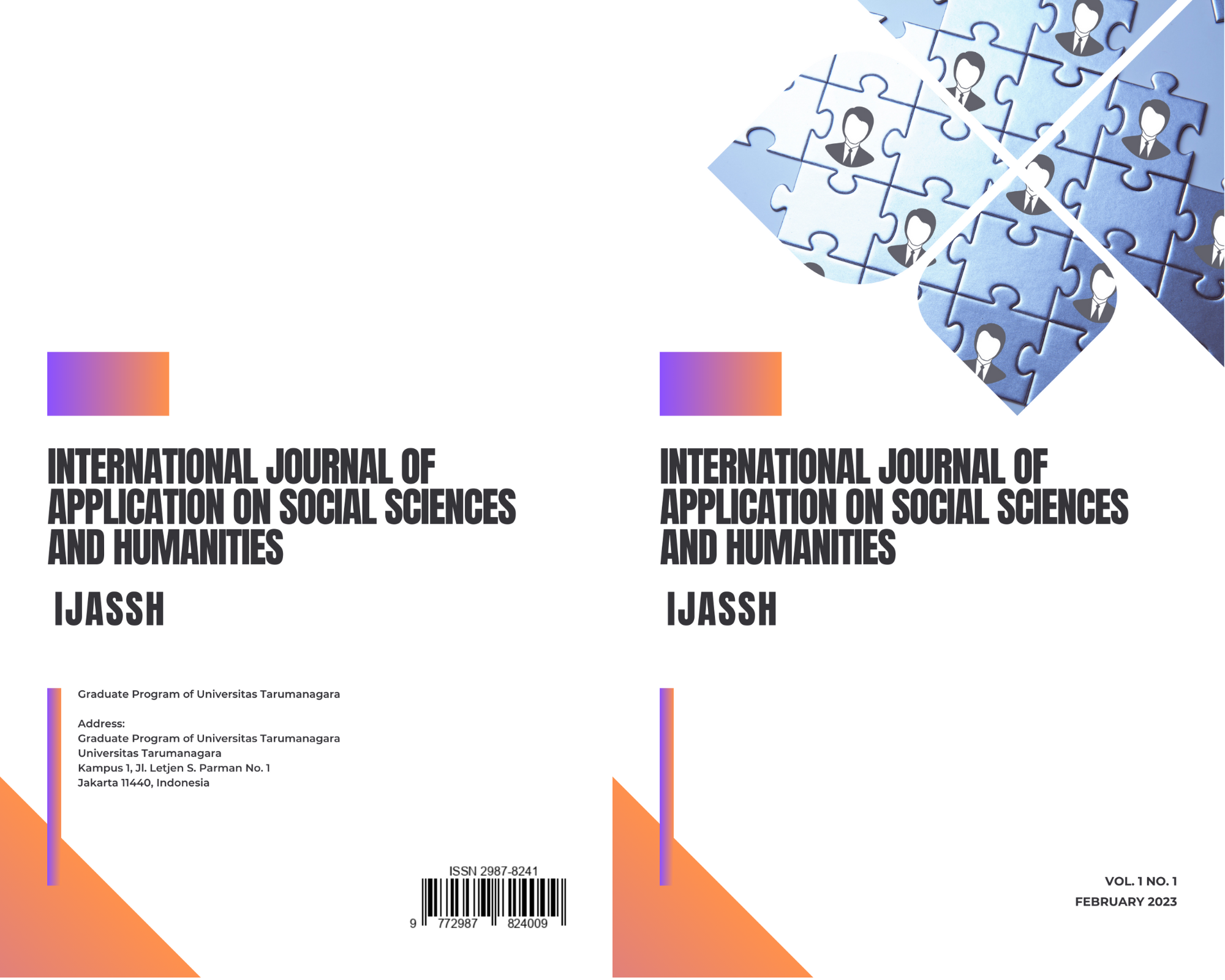STRONGER TOGETHER”: HOW MARRIED COUPLE STRATEGY TO WORK TOGETHER BRINGS IMPACT TO THE SATISFACTION OF RELATIONSHIP
Main Article Content
Abstract
The purpose of this research is to find the influence of dyadic coping on the relationship satisfaction of married couples. The research method that's been used for this research is quantitative non-experiment with non-probability sampling technique with 150 married couples as respondents or 300 respondents in total. The theory that’s been used for this research is the relationship satisfaction, in a definition is an evaluation of interpersonal towards a feeling of positivity one of the partners in a romantic relationship And also the dyadic coping theory which is defined as a strategy that couples did together as teamwork to deal with or cope with stressful life events. Based on the result of the research, had been found a conclusion that any individual whether they’re from the husbands or wives group of respondents, both of the group tend to practice positive dyadic coping more rather than negative dyadic coping. The research also shows that both of the husbands and wives group of respondents tend to practice emotionally focused coping on their dyadic coping strategy. Whereas on the husband’s group, their relationship satisfaction is much higher if there’s a lot of intimacy in their marriage. And for the wives group, the relationship satisfaction will increase if the marriage is filled with love. The interesting part that’s been discovered from this research is that both of the group whether from the husbands and wives who practice negative dyadic coping or the group of husbands and wives who practice positive dyadic coping, the husband’s sides are the sides who always have higher relationship satisfaction compared to the wives sides.
Article Details

This work is licensed under a Creative Commons Attribution-NonCommercial-ShareAlike 4.0 International License.
References
B. R. Karney and T. N. Bradbury, “The Longitudinal Course of Marital Quality and Stability: A Review of Theory, Method, and Research,” Psychological Bulletin, vol. 118, no. 1, pp. 3–34, 1995, DOI: 10.1037/0033-2909.118.1.3.
C. E. Rusbult and B. P. Buunk, “Commitment Processes in Close Relationships: An Interdependence Analysis,” Journal of Social and Personal Relationships, vol. 10, no. 2, pp. 175–204, 1993, DOI: 10.1177/026540759301000202.
D. A. Triningtyas and S. Muhayati, “Konseling Pranikah: Sebuah Upaya Meredukasi Budaya Pernikahan Dini di Kecamatan Pulung Kabupaten Ponorogo,” JKI (Jurnal Konseling Indonesia), vol. 3, no. 1, pp. 28–32, 2017, doi: https://doi.org/10.21067/jki.v3i1.1976.
E. Prayitno and Erlamsyah, Bahan Ajar Psikologi Keluarga. Padang: Fakultas Ilmu Pendidikan, Universitas Negeri Padang, 2002.
G. Bodenmann, “Dyadic Coping and Its Significance for Marital Functioning,” in Couples Coping with Stress: Emerging Perspectives On Dyadic Coping, Washington: American Psychological Association., 2005, pp. 33–49.
G. Bodenmann, A. K. Randall, and M. K. Falconier, “Coping in Couples: The Systemic Transactional Model (STM),” in Couples Coping With Stress: Across-Cultural Perspective., New York: Routledge, 2016, pp. 5–22.
G. Bodenmann, Dyadisches Coping Inventar: Test Manual [Dyadic Coping Inventory: Test Manual]. Bern: Huber, 2008. DOI: 10.1007/978-3-319-15877-8_678-1.
G. C. Gonzaga, B. Campos, and T. Bradbury, “Similarity, Convergence, and Relationship Satisfaction in Dating and Married Couples,” Journal of Personality and Social Psychology, vol. 93, no. 1, pp. 34–48, Jul. 2007, DOI: 10.1037/0022-3514.93.1.34.
G. J. O. Fletcher, J. A. Simpson, and G. Thomas, “The Measurement of Perceived Relationship Quality Components: A Confirmatory Factor Analytic Approach,” Personality and Social Psychology Bulletin, vol. 26, no. 3, pp. 340–354, 2000, DOI: 10.1177/0146167200265007.
H. Aini and Afdal, “Analisis Kesiapan Psikologis Pasangan dalam Menghadapi Pernikahan,” Jurnal Aplikasi IPTEK Indonesia, vol. 4, no. 2, pp. 136–146, Sep. 2020, doi: 10.24036/4.24372.
J. Holzapfel, A. K. Randall, C. Tao, and M. Lida, “Intercultural Couples’ Internal Stress, Relationship Satisfaction, and Dyadic Coping,” Interpersona, vol. 12, no. 2, pp. 145–163, 2018, DOI: 10.5964/ijpr.v12i2.302.
J. Miller and B. Tedder, Satisfaction in Romantic Relationships 1 The Discrepancy Between Expectations and Reality: Satisfaction in Romantic Relationships. Hanover College PSY 401: Advanced Research, 2011.
L. K. Guerrero, P. A. Anderson, and W. A. Afifi, Close Encounters: Communication in Relationships, 3rd ed. Los Angeles: Sage, 2011.
N. Tsania, D. Krisnatuti, and E. Sunarti, “Karakteristik Keluarga, Kesiapan Menikah Istri, dan Family Characteristics, Marital Readiness of Wife, and Development of Children Aged 3-5 Years,” Jurnal Ilmu Keluarga & Konsumen, vol. 8, no. 1, pp. 28–37, 2015, doi: https://doi.org/10.24156/jikk.2015.8.1.28.
P. P. Rusu, F. W. Nussbeck, L. Leuchtmann, and G. Bodenmann, “Stress, Dyadic Coping, and Relationship Satisfaction: A Longitudinal Study Disentangling Timely Stable from Yearly Fluctuations,” PLoS ONE, vol. 15, no. 4, pp. 1–23, Apr. 2020, DOI: 10.1371/journal.pone.0231133.
S. Novianty and Y. A. Goei, “Pengaruh Gratitude Terhadap Kepuasan Pernikahan,” Jurnal Psikologi Ulayat, vol. 1, no. 2, pp. 177–188, Dec. 2013, doi: 10.24854/jpu22013-19.
S. Saidiyah and V. Julianto, “Problem Pernikahan dan Strategi Penyelesaiannya: Studi Kasus pada Pasangan Suami Istri dengan Usia Perkawinan di Bawah Sepuluh Tahun,” Jurnal Psikologi Undip, vol. 15, no. 2, pp. 124–133, 2016, doi: https://doi.org/10.14710/jpu.15.2.124-133.
S. Sprecher and S. S. Hendrick, “Self-Disclosure in Intimate Relationships: Associations With Individual and Relationship Characteristics Over Time,” Journal Of Social And Clinical Psychology, vol. 23, no. 6, pp. 857–877, 2004.



